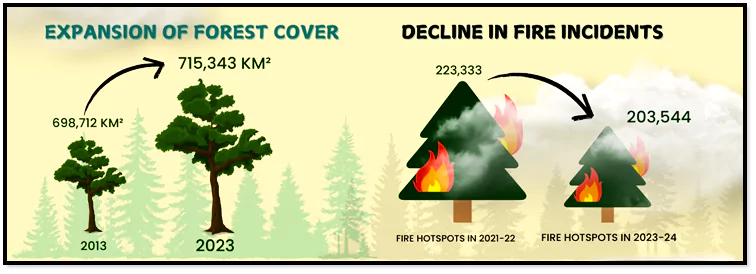The recently published ‘The India State of Forest Report (ISFR) 2023’ has highlighted the country’s successful efforts to balance development with environmental conservation.
Snapshot of The India State of Forest Report (ISFR) 2023
- ISFR is a biennial assessment of the country’s forest resources using satellite data and field information.
- The first report was published in 1987, and the ISFR 2023 marks the 18th edition.
- Published By: It is published by the Forest Survey of India (FSI) under the Ministry of Environment, Forest and Climate Change.
- Data Source: It utilizes satellite imagery from ISRO’s LISS-III sensor on IRS Resourcesat satellites.
- Volumes: The Report is published in 2 volumes,
- Volume-I: It is a national-level assessment with aspects like forest cover, mangrove cover, forest fires, growing stock, carbon stock, agroforestry, forest characteristics, and decadal changes
- Volume-II: It offers detailed information on forest cover and field inventory data for each State/UT, including district and forest division-wise forest cover data.
- Findings:
- Forest and Tree cover: It spans 827,357 square kilometers, covering 25.17% of the nation’s total land area.
- This includes 715,343 square kilometers (21.76%) of forest cover and 112,014 square kilometers (3.41%) of tree cover.
- Growth in Forest Cover: The Forest cover overall has increased from 698,712 km² in 2013 to 715,343 km² in 2023.
- Forest Fire Incidents: It has decreased, with 203,544 fire hotspots recorded in 2023-24, down from 223,333 in 2021-22.
- Carbon Sink: The country has achieved a carbon sink of 30.43 billion tonnes of CO2 equivalent representing an additional 2.29 billion tonnes of carbon sink in Forest and Tree Cover since 2005.

Enroll now for UPSC Online Course
Legal Framework for Forest and Wildlife Protection
- Constitutional Directive: Article 48A and 51A (g) of the Constitution underlines state’s and citizen’s duty to protect and improve the environment, including forests and wildlife.
- The Wildlife (Protection) Act, 1972: This act is the mainstay of forest conservation in India as it prohibits hunting, protects wildlife habitats, and establishes protected areas. It also regulates the trade of wildlife parts and products, and manages zoos.
- The Forest (Conservation) Act, 1980: This act prohibits diversion of forest and its resources for any non forestry purposes without the central government’s approval
- The Biological Diversity Act, 2002: This act aims to conserve biodiversity, use its components sustainably, and share the benefits of genetic resources fairly and equitably.
- State Forest Acts and Tree Preservation Acts: It caters to forest management specific to each state, while focusing on protecting trees in both urban and rural areas.
- Enforcement is the primary responsibility of State Governments and Union Territories.
Governmental Initiatives to Increase the Forest Cover
- National Mission for a Green India (GIM): It was launched in 2014 with the aims to enhance India’s forest cover through protection, restoration, and expansion initiatives via Joint Forest Management Committees (JFMCs).
- Compensatory Afforestation Fund Management and Planning Authority (CAMPA): This scheme compensates for the loss of forest cover and ecosystem services caused by the diversion of forest land for non-forestry purposes.
- Nagar Van Yojana (NVY): The scheme focuses on developing green spaces in urban and peri-urban areas
- Afforestation Targets under the Twenty-Point Programme: The Ministry sets annual afforestation targets for States/UTs, utilizing a mix of Central Government schemes, State Government plans, and efforts by NGOs, private organizations, and civil society.
- Indian Forest Management Standard: This standard establishes criteria and frameworks for monitoring sustainable forest management and supports the Indian Forest and Wood Certification Scheme, particularly benefiting small-scale timber producers.
- Mangrove Initiative for Shoreline Habitats & Tangible Incomes (MISHTI): This five-year initiative (2023-2028) seeks to restore and promote mangroves along India’s coastline, enhancing coastal habitats’ sustainability.
- National Action Plan on Forest Fire-2018: This plan provides measures to prevent forest fires, build resilience, and enhance community capacity for fire control and prevention.
- Joint Forest Management and Eco Development Committees: It has promoted community involvement through Joint Forest Management Committees (JFMCs) for better forest and wildlife protection, ensuring local participation in management and conservation activities
- National Plan for Conservation of Aquatic Ecosystems (NPCA):It aims for the conservation and management of wetlands in the country, on cost sharing basis between Central Government and respective State Governments
- Ek Ped Maa Ke Naam: Launched by the Prime Minister on 5th June 2024, this campaign encourages citizens to plant trees in honor of mothers, fostering a deep connection between nature and nurturing.
Community Involvement For Nature Protection
India has a history and culture which puts great emphasis on the idea of ‘living in harmony’ with the nature, showcased in the lifestyle of various communities and individuals.
- Example: Padma Shri Tulsi Gowda, also known as the “Mother of Trees,” dedicated years of her life for planting and nurturing lakhs of trees in Karnataka, transforming barren land into lush forest.
- Conservation Reserves and Community Reserves: These reserves provide a flexible system for wildlife conservation while also enhancing the socioeconomic circumstances of local populations
- Chipko Movement: This movement in Uttarakhand’s Chamoli district successfully resisted deforestation and showed how community afforestation can be successful.
- Sacred groves: Examples include Ajeevali village in Maharashtra, where religious sentiments are associated with the groves.
Check Out UPSC Modules From PW Store
- Tribal Protection: The Bishnois community in Rajasthan is at the forefront for protecting wildlife as they believes in the sanctity of all life, shunning meat and avoiding felling living trees.
- The community is actively involved in keeping watch over the poaching of wild animals and rescuing injured animals and often are a big support to the forest department.
- Community participation in forest management: Tribal communities and villagers in India have traditionally protected forests because their survival depended on them.
- Example: The Khasis community of Meghalaya has indigenous active governance organisations at the local level including multi-village governments (hima) and tribal village councils.
- Agroecoforestry: The Apatanis community of Arunachal Pradesh has evolved a unique skill of rice-fish cultivation where along with paddy, fish is also reared on the fields further supplemented with millets reared on elevated partition bunds between the rice plots.
Additional Reading: About the ISFR 2023
![]() 30 Dec 2024
30 Dec 2024


